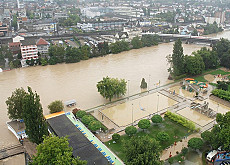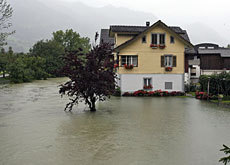
|
| ©Keystone |
| The River Aare flooded parts of Olten in northern Switzerland. |
By Thursday evening the levels of most affected lakes and rivers appeared to have peaked, but the situation in many areas, particularly along the River Aare, remained critical.

|
| ©Keystone |
| The River Sarneraa burst its banks at Sarnen in canton Obwalden. |
The storms, the worst since the severe floods of 2005, led to chaos on the roads, with many closed as a result of flooding or landslides. Rail traffic was also hit.
Thousands of policeman, firemen, civil defence workers and soldiers battled to pump water out of flooded cellars and clear roads, and hundreds of residents had to be led to safety as river levels rose.
Certain regions experienced record downpours. In canton Jura 150 litres per square metre fell over a 72-hour period - the same amount as it normally receives during the entire month of August.
Zurich was also hit by its worst rainfall in a century, with 100 litres per square metre falling in 24 hours between Wednesday and Thursday.
MeteoSwiss said 74 litres of rain per square metre had fallen on Bern in the same period. Other badly affected areas were the Chasseral in canton Bern (90 litres), the Moléson in canton Fribourg (80 litres) and Lugano (70 litres).
Overflowing
Eight people were reported hurt in the storms. One man was seriously injured by an uprooted tree in Littau near Lucerne. A fireman was admitted to hospital in Bern, and another was in a Fribourg hospital after suffering from carbon monoxide poisoning.
In canton Aargau the high water situation along the Aare was described as acute, with many homes under more water than in the flooding of 2005.
In canton Bern, the heavy rains caused the lakes of Thun, Brienz and Biel to overflow. Residents of the low-lying Matte area of Bern managed to avoid the worst and fought off the water of the River Aare with sandbags, but several properties were damaged.
The city's camping ground was evacuated and people were taken to safety at similar grounds in Brienz and Unterseen in the Bernese Oberland.
Animals at Bern's zoo, parts of which are located next to the River Aare, were also moved to safety, and several areas of the town were left without electricity.
Acute
Emergency services in canton Fribourg received over one thousand calls from people whose homes and property had been flooded.
Canton Jura was also badly hit by the torrential rain, especially the capital, Delémont, which was cut off, with roads closed and rail links cut.
In the Chablais region, the village of Roche and three nearby campsites were badly damaged after the River Eau froide burst its banks.
Police in Solothurn reported that the situation in the town of Olten, a strategic crossroads of Switzerland's rail network, was particularly precarious, with parts of the town centre under water.
In Basel, the River Rhine threatened to burst its banks and shipping was halted.
Railway services across central Switzerland were disrupted following a series of landslides, a spokesman for the Swiss Federal Railways said.
The regions where rail transport was worst affected by flooding were northwestern Switzerland, the central plateau and Winterthur, north of Zurich.
The line between Bern and Fribourg was closed, with buses replacing the train service.
By Thursday evening the rain had ceased across most of the country and water levels had started to stabilise. MeteoSwiss predicted drier conditions with scattered showers for Friday and the weekend.



Reader Comments
to our Newsletter